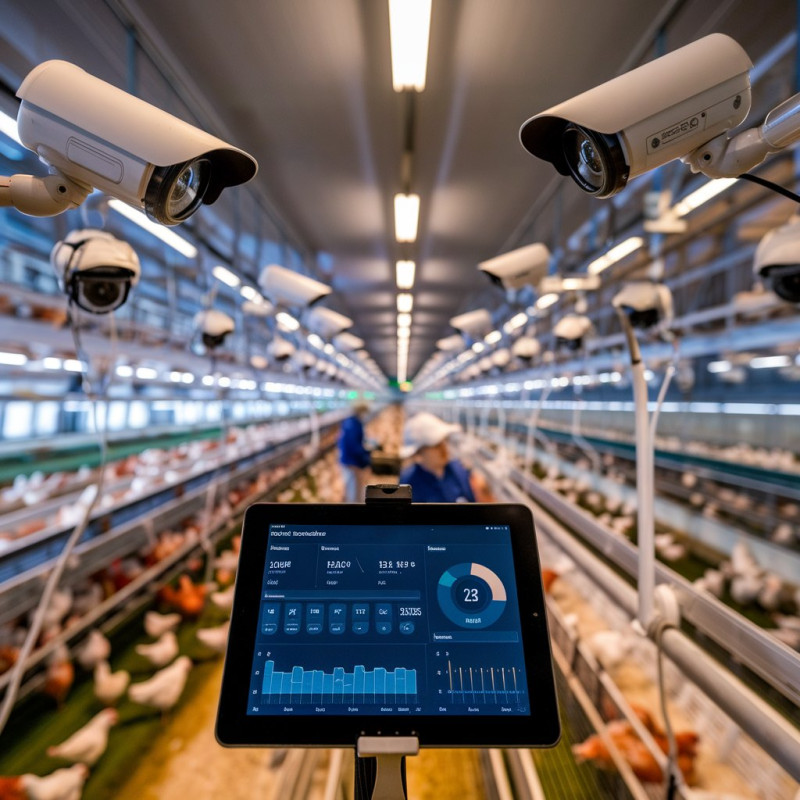How Modern Poultry Farms Are Incorporating Technology
Date : 2024-12-18
In recent years, poultry farming has evolved dramatically, driven by advancements in technology that streamline operations, enhance productivity, and ensure sustainability. As the global demand for poultry products continues to rise, modern poultry farms are adopting cutting-edge solutions to meet these demands while addressing challenges such as animal welfare, food safety, and environmental concerns. This blog explores the role of technology in shaping the future of poultry farming.
1. Automation: Revolutionizing Poultry Farm Operations
Automation has become a cornerstone of modern poultry farming, simplifying tasks that were once labor-intensive. From automated feeding systems to egg collection and waste management, automation enhances operational efficiency and reduces labor costs. For instance:
Automated Feeding Systems: These systems use sensors to monitor the amount of food needed and distribute it accordingly, ensuring that poultry receive the right nutrition at the right time.
Robotic Egg Collectors: Automated machines help collect eggs, reducing the risk of damage and contamination while saving time.
Waste Management: Automated systems also manage waste disposal, ensuring that manure is efficiently collected and processed, reducing environmental impact.
2. IoT (Internet of Things): Smarter Farms with Real-Time Monitoring
The integration of the Internet of Things (IoT) in poultry farming is transforming how farms are managed. IoT-enabled devices such as sensors and smart cameras provide real-time data that help farmers make informed decisions, optimize production, and monitor the health of their flocks. Key applications of IoT include:
Temperature and Humidity Control: IoT sensors monitor the barn environment, ensuring optimal conditions for poultry growth and health. Automated systems adjust temperature and humidity levels to maintain ideal conditions.
Health Monitoring: Wearable sensors on poultry can track movement, temperature, and other vital signs, helping farmers detect early signs of illness and prevent disease outbreaks.
Feed and Water Monitoring: IoT devices monitor feed and water consumption, allowing farmers to optimize these resources and prevent wastage.
3. AI and Data Analytics: Predicting Trends and Enhancing Decision-Making
Artificial Intelligence (AI) and data analytics are becoming essential tools in poultry farming. By collecting and analyzing large amounts of data, AI helps farmers predict trends, optimize flock management, and improve productivity. Some key uses of AI in poultry farms include:
Predictive Analytics: AI can predict flock growth rates, egg production, and even potential health issues by analyzing historical data and current conditions.
Animal Behavior Analysis: AI-powered cameras and software can track poultry behavior, detecting signs of stress or illness early, which can lead to quicker intervention and reduced losses.
Optimization of Resources: By analyzing data on feed, water, and environmental conditions, AI can help optimize resource usage, leading to more sustainable farming practices.
4. Drones: Monitoring Large Poultry Farms Efficiently
Drones are becoming an essential tool for large-scale poultry farms. These unmanned aerial vehicles provide a cost-effective way to monitor farm conditions, track flock movement, and identify potential issues. Benefits of drone technology in poultry farming include:
Flock Monitoring: Drones can survey large farms, checking the condition of poultry and their surroundings from a bird’s-eye view.
Inspection and Surveillance: Drones help farmers spot issues such as disease outbreaks or equipment malfunctions without having to physically walk the entire farm.
Land and Infrastructure Assessment: Drones can map and assess farm infrastructure, such as fencing, water systems, and feed distribution, improving farm management efficiency.
5. Blockchain: Ensuring Food Safety and Transparency
In an era where consumers demand transparency and food safety, blockchain technology is making waves in poultry farming. By tracking every step of the supply chain, from farm to table, blockchain ensures the integrity of poultry products and builds trust with consumers. Key benefits of blockchain include:
Traceability: Blockchain provides a transparent and immutable record of poultry products, allowing consumers to trace the origin of their food and verify its safety.
Disease Prevention: Blockchain can also be used to track the health status of poultry throughout their lifecycle, helping to prevent the spread of diseases.
Supply Chain Transparency: By tracking every transaction and movement of poultry products, blockchain reduces the risk of fraud and ensures the authenticity of the products.
6. Sustainability: Reducing the Environmental Footprint
Sustainability is a major concern for the poultry industry, and technology is playing a crucial role in reducing the environmental footprint of farms. Several technological advancements are helping poultry farms become more eco-friendly, such as:
Energy-Efficient Systems: Modern poultry barns use energy-efficient lighting, ventilation, and heating systems that reduce energy consumption and lower greenhouse gas emissions.
Water Conservation: Technology helps farmers monitor water usage and implement more efficient irrigation systems, conserving this vital resource.
Waste-to-Energy Technology: Some poultry farms are using waste-to-energy systems that convert poultry litter into energy, providing an environmentally-friendly solution for waste disposal.
7. Smart Breeding: Enhancing Poultry Genetics
Technology is also advancing in the realm of breeding, where genetic improvements are crucial for improving productivity, disease resistance, and overall flock health. Smart breeding techniques, powered by AI and genetic analysis, are enabling farmers to:
Identify Superior Genetics: Through genetic testing and AI, farmers can select the best breeding candidates to enhance desirable traits such as egg production, growth rates, and disease resistance.
Reduce Disease Transmission: By focusing on disease-resistant traits, smart breeding techniques help reduce the risk of outbreaks and improve animal welfare.
Conclusion: The Future of Poultry Farming is Tech-Driven
The integration of technology in poultry farming is revolutionizing the industry, providing farmers with the tools they need to improve efficiency, enhance sustainability, and ensure animal welfare. From automation and IoT to AI and blockchain, these innovations are shaping the future of poultry farming. As the industry continues to evolve, technology will play an increasingly vital role in meeting the growing demand for poultry products while addressing global challenges related to food security, environmental sustainability, and animal welfare.
By embracing these technological advancements, poultry farmers are not only enhancing productivity but also contributing to a more sustainable and transparent food system. The future of poultry farming is undoubtedly tech-driven, and the possibilities for innovation are limitless.